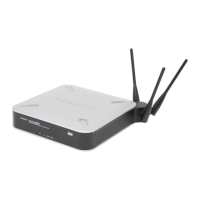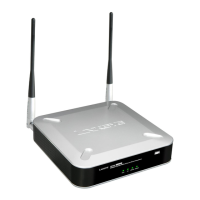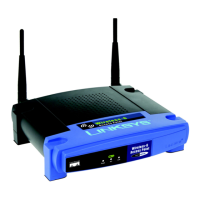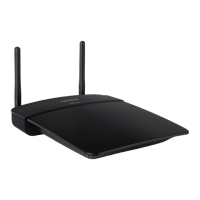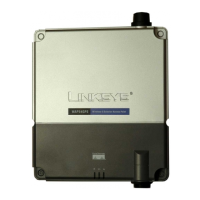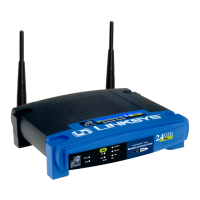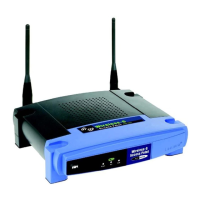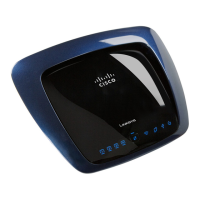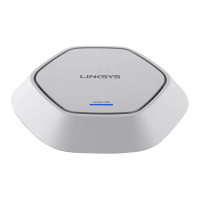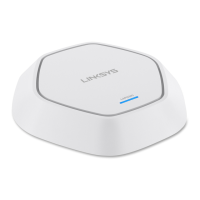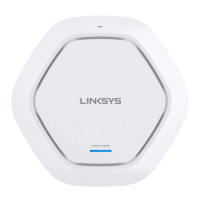Do you have a question about the Linksys WAP4410N and is the answer not in the manual?
Explains how to use the guide, including warnings, notes, and cautions.
Details typographic conventions used in the document for menus, fields, and parameters.
Explains how to use PDF's Find/Search tools for single or multiple documents.
Welcomes the user and introduces the Wireless-N Access Point's capabilities and features.
Explains wireless and infrastructure network topologies and access point functions.
Discusses roaming capabilities for mobile users in infrastructure mode.
Details compatibility with wireless standards and connection methods using PoE.
Illustrates a typical infrastructure wireless network setup with an access point, switch, and router.
Explains the function of each LED indicator on the front panel of the Access Point.
Details the Power, Ethernet, and Reset button ports on the back of the device.
Mentions placement options for the Access Point (stackable, standalone, wall-mount).
Describes the three detachable omni-directional antennas and their role in MIMO.
Introduces the chapter on placing and connecting the Access Point.
Provides steps for connecting the Ethernet cable and power adapter.
Outlines three ways to place the Access Point: horizontally, vertically, or wall-mounted.
Details the steps for attaching the provided stands to position the Access Point vertically.
Explains how to mount the Access Point on a wall using screws.
Introduces the chapter on using the Web-based Utility for basic settings.
Describes three methods to connect to the Access Point's Web-based Utility for the first time.
Explains the main tabs (Setup, Wireless, AP Mode, Administration, Status) and their sub-tabs.
Outlines the management functions available under the Administration tab.
Details the status information available for local network, wireless, and system performance.
Explains how to configure host name and network settings, including IP addresses.
Explains IP settings (v4, v6), subnet mask, gateway, and DNS configuration.
Describes how to set the Access Point's date and time manually or automatically.
Covers advanced setup settings like HTTP Redirect and 802.1x Supplicant.
Details how to configure wireless network mode, channel, and SSID.
Explains how to set up wireless security modes like WPA, WPA2, and WEP.
Details WPA-Personal and WPA2-Personal security modes, algorithms, and keys.
Details WPA2-Personal Mixed and WPA-Enterprise security modes and RADIUS server settings.
Details WPA2-Enterprise and WPA2-Enterprise Mixed security modes and RADIUS settings.
Explains RADIUS server authentication and WEP security modes.
Describes how to configure connection control using MAC addresses or RADIUS.
Details Local MAC filtering and RADIUS server connection control options.
Explains how to configure WPS settings for simple setup and security.
Covers configuration of VLAN and QoS settings for traffic prioritization.
Details VLAN ID, Tagging, AP Management VLAN, and QoS priority settings.
Explains advanced parameters like Country/Region, Channel Bandwidth, and Guard Interval.
Details load balancing, DTIM interval, RTS threshold, and fragmentation settings.
Covers configuration of different AP modes like Repeater and Client.
Details options for operating as an Access Point or WDS Repeater.
Explains how to manage user name, password, and SNMP settings.
Covers Web Access (HTTPS, Wireless Web Access) and SNMP configuration.
Details configuration for email alerts, syslog notifications, and log event selection.
Explains how to perform a Ping test for network troubleshooting.
Describes how to restore the Access Point to its factory default settings.
Outlines the process for upgrading the Access Point's firmware.
Continues explaining the steps to download and install firmware updates.
Explains how to remotely reboot the Access Point.
Details how to save and restore configuration files for the Access Point.
Displays current status information for the local network, including hardware and software versions.
Shows current status information for wireless networks, including mode, channel, and security.
Displays status information for wired and wireless network performance metrics.
Details wired and wireless performance statistics like packets sent/received.
Provides answers to common questions about DHCP, network applications, and client compatibility.
Answers questions about IEEE 802.11b, 802.11g, and 802.11n standards.
Explains IEEE 802.11b/g features, IPv6 features, Ad-hoc, Infrastructure, and Roaming.
Defines Spread Spectrum, DSSS, FHSS, security interception, file sharing, WEP, and MAC Address.
Addresses interference, resetting the Access Point, signal loss, firewall function, and network visibility.
Explains the necessity of TCP/IP for PC communication with the Access Point.
Refers to Windows Help for instructions on sharing resources and adding PCs.
Lists security precautions like changing SSID, password, and using encryption.
Discusses SSID broadcasting, default SSIDs, MAC filtering, WEP, WPA/WPA2 security.
Provides step-by-step instructions on how to upgrade the Access Point's firmware.
Defines networking terms starting with A through D.
Defines networking terms starting with D through I.
Defines networking terms starting with N through P.
Defines networking terms starting with S through W.
Provides contact details for Linksys technical support, website, and sales in the US/Canada.
Lists website and product registration contact information for the EU region.
Outlines the limited warranty terms for the Linksys hardware product.
Lists conditions under which the limited warranty does not apply.
Explains the process for obtaining warranty service, including RMA procedures.
Provides information about Linksys' technical support offerings and policies.
Details compliance with FCC Part 15 limits and warns against unauthorized modifications.
States compliance with FCC RF exposure limits and minimum separation distance.
Lists standards (ANSI, ICNIRP) and states minimum separation distances for RF exposure.
Provides safety information regarding aircraft use, medical devices, and general precautions.
Details Industry Canada compliance conditions and antenna restrictions.
Provides EU WEEE directive information on proper disposal of electronic equipment.
Describes the software included in Linksys products and license terms.
Presents the main Linksys Software License Agreement.
Details the nonexclusive license granted to the end-user purchaser of the software.
Discusses software upgrades, protection of information, and open source licenses.
Presents the GNU General Public License, Version 2.
Outlines the terms and conditions for copying, distribution, and modification of software.
Continues detailing terms for distribution, modification, and warranty disclaimers.
Refers to OpenSSL license terms for open source software.
Presents the specific terms of the OpenSSL License.
Continues the OpenSSL License terms and copyright information.
Presents the original SSLeay license terms.
Continues the SSLeay license terms and disclaimer.
Specifies the product model as WAP4410N.
Lists the wireless and networking standards supported by the device.
Lists the available ports and buttons on the Access Point.
Lists the different operating modes supported by the Access Point.
Covers wireless security protocols, MAC filtering, and SSID broadcast.
Details features like Load Balancing, 802.11d, Client Isolation, 802.1x, and WPS.
Details QoS features, supported modulation types, and operating channels.
Specifies the number and type of external antennas.
Lists transmit power and receiver sensitivity values for different standards.
Details power requirements, maximum draw, and product certifications.
Specifies the operating and storage temperature and humidity ranges.
Explains how to use the guide, including warnings, notes, and cautions.
Details typographic conventions used in the document for menus, fields, and parameters.
Explains how to use PDF's Find/Search tools for single or multiple documents.
Welcomes the user and introduces the Wireless-N Access Point's capabilities and features.
Explains wireless and infrastructure network topologies and access point functions.
Discusses roaming capabilities for mobile users in infrastructure mode.
Details compatibility with wireless standards and connection methods using PoE.
Illustrates a typical infrastructure wireless network setup with an access point, switch, and router.
Explains the function of each LED indicator on the front panel of the Access Point.
Details the Power, Ethernet, and Reset button ports on the back of the device.
Mentions placement options for the Access Point (stackable, standalone, wall-mount).
Describes the three detachable omni-directional antennas and their role in MIMO.
Introduces the chapter on placing and connecting the Access Point.
Provides steps for connecting the Ethernet cable and power adapter.
Outlines three ways to place the Access Point: horizontally, vertically, or wall-mounted.
Details the steps for attaching the provided stands to position the Access Point vertically.
Explains how to mount the Access Point on a wall using screws.
Introduces the chapter on using the Web-based Utility for basic settings.
Describes three methods to connect to the Access Point's Web-based Utility for the first time.
Explains the main tabs (Setup, Wireless, AP Mode, Administration, Status) and their sub-tabs.
Outlines the management functions available under the Administration tab.
Details the status information available for local network, wireless, and system performance.
Explains how to configure host name and network settings, including IP addresses.
Explains IP settings (v4, v6), subnet mask, gateway, and DNS configuration.
Describes how to set the Access Point's date and time manually or automatically.
Covers advanced setup settings like HTTP Redirect and 802.1x Supplicant.
Details how to configure wireless network mode, channel, and SSID.
Explains how to set up wireless security modes like WPA, WPA2, and WEP.
Details WPA-Personal and WPA2-Personal security modes, algorithms, and keys.
Details WPA2-Personal Mixed and WPA-Enterprise security modes and RADIUS server settings.
Details WPA2-Enterprise and WPA2-Enterprise Mixed security modes and RADIUS settings.
Explains RADIUS server authentication and WEP security modes.
Describes how to configure connection control using MAC addresses or RADIUS.
Details Local MAC filtering and RADIUS server connection control options.
Explains how to configure WPS settings for simple setup and security.
Covers configuration of VLAN and QoS settings for traffic prioritization.
Details VLAN ID, Tagging, AP Management VLAN, and QoS priority settings.
Explains advanced parameters like Country/Region, Channel Bandwidth, and Guard Interval.
Details load balancing, DTIM interval, RTS threshold, and fragmentation settings.
Covers configuration of different AP modes like Repeater and Client.
Details options for operating as an Access Point or WDS Repeater.
Explains how to manage user name, password, and SNMP settings.
Covers Web Access (HTTPS, Wireless Web Access) and SNMP configuration.
Details configuration for email alerts, syslog notifications, and log event selection.
Explains how to perform a Ping test for network troubleshooting.
Describes how to restore the Access Point to its factory default settings.
Outlines the process for upgrading the Access Point's firmware.
Continues explaining the steps to download and install firmware updates.
Explains how to remotely reboot the Access Point.
Details how to save and restore configuration files for the Access Point.
Displays current status information for the local network, including hardware and software versions.
Shows current status information for wireless networks, including mode, channel, and security.
Displays status information for wired and wireless network performance metrics.
Details wired and wireless performance statistics like packets sent/received.
Provides answers to common questions about DHCP, network applications, and client compatibility.
Answers questions about IEEE 802.11b, 802.11g, and 802.11n standards.
Explains IEEE 802.11b/g features, IPv6 features, Ad-hoc, Infrastructure, and Roaming.
Defines Spread Spectrum, DSSS, FHSS, security interception, file sharing, WEP, and MAC Address.
Addresses interference, resetting the Access Point, signal loss, firewall function, and network visibility.
Explains the necessity of TCP/IP for PC communication with the Access Point.
Refers to Windows Help for instructions on sharing resources and adding PCs.
Lists security precautions like changing SSID, password, and using encryption.
Discusses SSID broadcasting, default SSIDs, MAC filtering, WEP, WPA/WPA2 security.
Provides step-by-step instructions on how to upgrade the Access Point's firmware.
Defines networking terms starting with A through D.
Defines networking terms starting with D through I.
Defines networking terms starting with N through P.
Defines networking terms starting with S through W.
Provides contact details for Linksys technical support, website, and sales in the US/Canada.
Lists website and product registration contact information for the EU region.
Outlines the limited warranty terms for the Linksys hardware product.
Lists conditions under which the limited warranty does not apply.
Explains the process for obtaining warranty service, including RMA procedures.
Provides information about Linksys' technical support offerings and policies.
Details compliance with FCC Part 15 limits and warns against unauthorized modifications.
States compliance with FCC RF exposure limits and minimum separation distance.
Lists standards (ANSI, ICNIRP) and states minimum separation distances for RF exposure.
Provides safety information regarding aircraft use, medical devices, and general precautions.
Details Industry Canada compliance conditions and antenna restrictions.
Provides EU WEEE directive information on proper disposal of electronic equipment.
Describes the software included in Linksys products and license terms.
Presents the main Linksys Software License Agreement.
Details the nonexclusive license granted to the end-user purchaser of the software.
Discusses software upgrades, protection of information, and open source licenses.
Presents the GNU General Public License, Version 2.
Outlines the terms and conditions for copying, distribution, and modification of software.
Continues detailing terms for distribution, modification, and warranty disclaimers.
Refers to OpenSSL license terms for open source software.
Presents the specific terms of the OpenSSL License.
Continues the OpenSSL License terms and copyright information.
Presents the original SSLeay license terms.
Continues the SSLeay license terms and disclaimer.
Specifies the product model as WAP4410N.
Lists the wireless and networking standards supported by the device.
Lists the available ports and buttons on the Access Point.
Lists the different operating modes supported by the Access Point.
Covers wireless security protocols, MAC filtering, and SSID broadcast.
Details features like Load Balancing, 802.11d, Client Isolation, 802.1x, and WPS.
Details QoS features, supported modulation types, and operating channels.
Specifies the number and type of external antennas.
Lists transmit power and receiver sensitivity values for different standards.
Details power requirements, maximum draw, and product certifications.
Specifies the operating and storage temperature and humidity ranges.
| Wireless Standards | IEEE 802.11n, 802.11g, 802.11b |
|---|---|
| Frequency Band | 2.4 GHz |
| Maximum Data Rate | 300 Mbps |
| Power over Ethernet (PoE) | Yes |
| Antennas | 2 external antennas |
| Ports | 1 x 10/100 Ethernet (RJ-45) |
| Security | WPA, WPA2, WEP |
| Operating Modes | Access Point, Wireless Client |
| Standards | IEEE 802.3, IEEE 802.3u |
